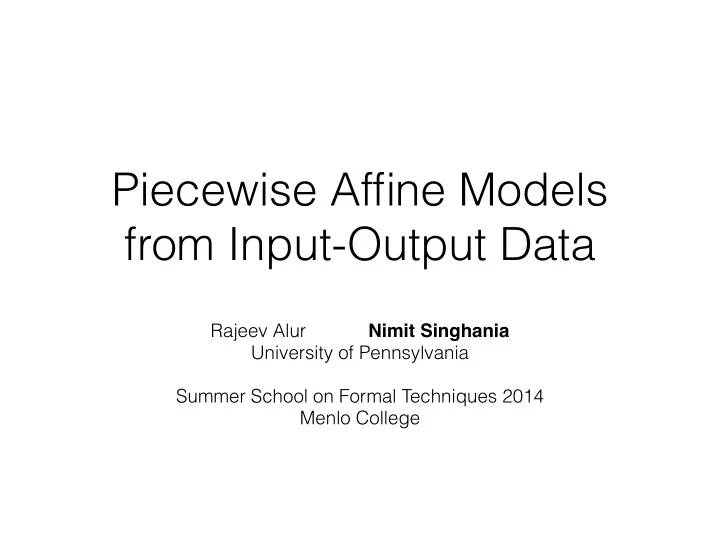

Piecewise Affine Models from Input-Output Data Rajeev Alur Nimit Singhania � University of Pennsylvania � Summer School on Formal Techniques 2014 Menlo College
Problem • To represent real valued Input-Output Data D succinctly using a piecewise linear function • A piecewise linear function • Input domain partitioned into regions • Each region mapped to a linear function • Region represented by a guard condition
Example 30 0 0 0 0 45 55 65 0 0 0 0 35 45 55 20 (10, 10) → 25 10 0 0 0 0 25 35 45 x 2 (0, 0) → 0 0 0 0 0 0 0 0 0 − 10 − 35 − 25 − 15 0 0 0 27 (20, -20) → 17 − 20 − 45 − 35 − 25 0 0 17 27 − 55 − 45 − 35 0 7 17 27 − 30 − 30 − 20 − 10 0 10 20 30 x 1
Example 30 x1 + x2 + 5 x 1 � 5 20 10 x 2 � 5 x 2 0 0 x 2 � − 5 − 10 5 3 − � x 1 � − 5 x 1 − 20 − x1 - 3 x 2 − 30 − 30 − 20 − 10 0 10 20 30 x 1
Example • Piecewise Linear Function ƒ: guard condition ƒ(x1, x2) = if x2 − x1 ≤ − 35 then linear function x1 − 3 else if (x1 ≤ − 5 ∧ x2 ≤ − 5) ∨ (5 ≤ x1 ∧ 5 ≤ x2) then x1 + x2 + 5 else 0
Solution • In 2 phases • Find a set of linear functions L • Find guard condition for each linear function in L • Optimal solutions to both problems are NP-Hard • Only best effort solution
Finding Linear Functions • To find a set of linear functions L such that • each (x, y) in D is represented by a linear function in L • Learn L iteratively • Pick a random point p in D • Find a linear function that represents points in the neighborhood of p and add it to L • Remove the covered points from D and repeat
Finding Linear Functions • Say 3 linear functions 30 found for the example 20 • l1: x1 - 3 10 • l2: x1 + x2 + 5 x 2 0 • l3: 0 − 10 − 20 • Every point in D represented by a linear − 30 function − 30 − 20 − 10 0 10 20 30 x 1
Finding Guards • To find guard condition Φ for the linear function l in L • marks the region where l is defined • Φ is true on points represented by l , marked positive • Φ is false on points not represented by l, marked negative • Φ needs to separate positive and negative points • Problem of learning a precise binary classifier • Problem of learning interpolant
Guard for l1 Negative 30 20 10 x 2 0 Positive − 10 − 20 − 30 − 30 − 20 − 10 0 10 20 30 x 1
Guard for l2 30 20 10 x 2 0 − 10 − 20 − 30 − 30 − 20 − 10 0 10 20 30 x 1
Precise Classifiers • Find groups of positive and negative points • Each positive and negative group can be separated by a linear inequality • Combine inequalities so that all positive groups can be separated from negative groups
Guard for l2 30 20 10 x 2 0 − 10 − 20 − 30 − 30 − 20 − 10 0 10 20 30 x 1
Precise Classifiers • Use counter example guided approach to learn these groups • Start with a single positive and negative point as positive and negative group. • Iteratively update groups using counter examples until correct classifier is found • Based on interpolant learning technique • “Beautiful Interpolants” by Albarghouthi et. al in CAV 2013.
Conclusion • Presented a technique to represent input-output data using piecewise linear functions • Combined use of machine learning and verification techniques • One potential application in modeling hybrid systems • Questions?
Recommend
More recommend